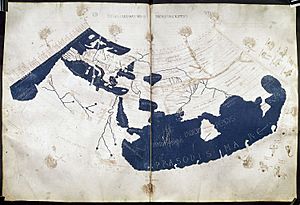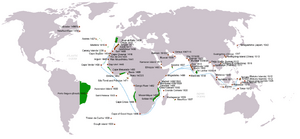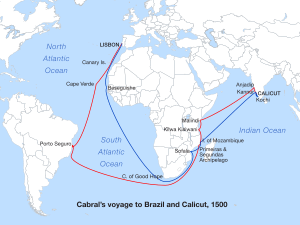Cape Route facts for kids



The Cape Route is a very important shipping route that connects Europe to Asia. It goes around the southern tip of Africa, passing by the Cape of Good Hope and Cape Agulhas. The first time someone officially sailed this whole route was in 1498. This was done by a Portuguese explorer named Vasco da Gama. He was the leader of the first Portuguese ships to sail east and find this route. The Cape Route was super important during the time of sailing ships, but it became less used after the Suez Canal opened in 1869.
Contents
History of the Route
Long ago, in ancient times, people weren't sure if the Atlantic Ocean was connected to the Indian Ocean. There are old stories about ships sailing all the way around Africa. For example, a story by Herodotus says that Phoenician sailors, sent by an Egyptian king around 600 BC, sailed from the Red Sea all the way to the Nile River. Another explorer, Eudoxus of Cyzicus, tried to explore the west coast of Africa but had to turn back. The maps used in the Middle Ages were based on Ptolemy's world map, which showed the oceans as separate.
Finding the Sea Route
In the late Middle Ages, spices from India and goods from China (like silk) were very valuable. They were brought to Europe through land routes like the Silk Road. But when the city of Constantinople fell in 1453, it made trade much harder. This made Europeans really want to find a sea route to Asia.
Portuguese explorers started looking for this route. Diogo Cão explored the African coast south to where Namibia is today. Then, Bartolomeu Dias found the Cape of Good Hope in 1488. Finally, Vasco da Gama led an expedition that successfully found the sea route to India in 1498. After this, many more Portuguese ships used this route.
Around the same time, Christopher Columbus tried to find a sea route to India by sailing west. Instead, he found the Americas. These journeys marked the start of the Age of Discovery, when European explorers mapped out the world's oceans.
Using the Route with Sailing Ships
The Cape Route was used a lot by European trading companies, like the East India Companies. In the 1600s, some pirates even used a similar route, called the "Pirate Round," to sail from the Caribbean to the Indian Ocean.
For a long time, European countries only had a few small bases along the African coast. These bases were mainly there to support ships using the Cape Route. For example, the Dutch East India Company set up the Dutch Cape Colony in South Africa. It was a useful stop for ships on their way to the Dutch East Indies (today's Indonesia).
Other routes also developed from the Cape Route. The Brouwer Route was an extension across the Indian Ocean to Indonesia. The Clipper Route was another path used by fast sailing ships, called clippers, between Europe and Australia.
The Suez Canal's Impact
The Suez Canal opened in 1869. This canal created a much shorter path between the Atlantic and Indian Oceans, cutting right through Egypt. Because of the winds in the Suez Canal, it was not ideal for sailing ships. This gave an advantage to steamships, which could use the canal easily.
Even though the Cape Route was still used by clippers for a few more decades, the opening of the Suez Canal marked the beginning of the end for the Cape Route as the main way to Asia. It also signaled the end of the Age of Sail. Today, the route around the Cape is still popular for yacht racing.
Ships that are too big to fit through the Suez Canal are called Capesize ships. They still need to use the Cape Route. In 2015, the New Suez Canal opened, allowing even larger ships to pass through. This made the Cape Route even less important for regular trade. However, it still serves as a backup route if the Suez Canal is blocked (like during the 2021 Suez Canal obstruction). Ships might also use it to avoid paying fees for the canal if it's cheaper to take the longer route. Sailing around the Cape can add up to two weeks to a modern ship's journey compared to using the Suez Canal.
Images for kids
-
Ptolemy's world map implied that Africa was part of an outer landmass, separating the Atlantic from the Indian Ocean.
-
The early Portuguese empire centered around the Cape Route.
-
In 1500, Portuguese explorer Pedro Álvares Cabral used the prevailing winds on the Atlantic for a volta do mar, and thereby became the first European to arrive in Brazil. European sailors found the stop useful on the way to India.
-
Since the Suez Canal opened, the Cape Route has been used when passage through Suez is refused, or by Capesize ships. In the 1904-05 Russo-Japanese War, the Dogger Bank incident forced the Russian fleet to sail around Africa.
See also
 In Spanish: Ruta del Cabo para niños
In Spanish: Ruta del Cabo para niños






